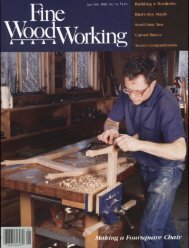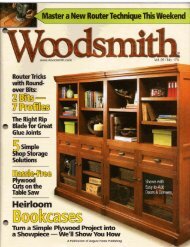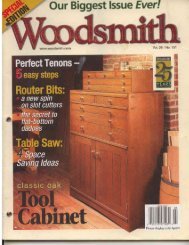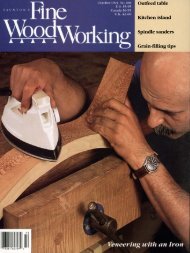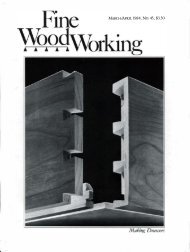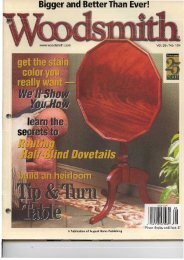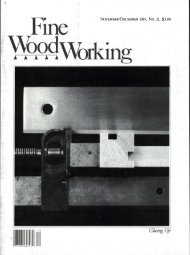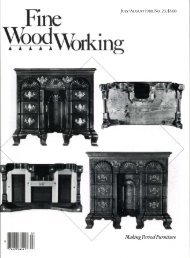Shaping with a Router - MetosExpo - Free
Shaping with a Router - MetosExpo - Free
Shaping with a Router - MetosExpo - Free
Create successful ePaper yourself
Turn your PDF publications into a flip-book with our unique Google optimized e-Paper software.
Methods of Work (co1ltinued)<br />
Place the right-side fence back fa r enough to allow room between<br />
the fences for the workpiece. 111e best miter cuts are made if d1e<br />
workpieces are held firmly in place on d1e table. To accomplish<br />
this, install toggle clamps on the fences. Bear in mind that the<br />
right toggle clamp will interfere <strong>with</strong> the saw's motor unless it is<br />
placed well back on d1e right-side fence. To finish the setup,<br />
remove d1e hardboard insert and cut through d1e fence overlaps.<br />
You are now ready to produce perfect miters.<br />
-Tom Stipanovich, Cambridge, Ont., Canada<br />
Quick tip: Use a good pencil sharpener on the end of a dowel<br />
to form a point d1at can reach into an inside corner to remove<br />
fresh glue. You can also sand d1e tip of the dowel at an angle<br />
and use it to clean out dado grooves.<br />
-L. Frederick, Aspen, Colo.<br />
Gluing up mitered legs<br />
got an idea. Instead of making each leg separately, I made all<br />
four at once. The trick was to glue up a long mitered box using<br />
strap clan1ps and then to rip through the middle of each side to<br />
form the four legs. -Steven H. Klotz, West Bloomfield, Mich.<br />
Hot-melt glue blocks<br />
Fasten each clamping<br />
perch <strong>with</strong> a dab<br />
of hot-melt glue.<br />
Glue up mitered box using strap<br />
clamps, and then rip through sides to fo rm legs.<br />
I designed a coffee table <strong>with</strong> 3-in.-wide, L-shaped legs mitered<br />
at d1e corners. But <strong>with</strong> my small selection of clamps, I couldn't<br />
figure out an easy way to glue up the mitered leg joints. Then I<br />
Mitered glue joints are almost impossible to clamp even using<br />
expensive corner clamps and other jigs. Here is a simple way to<br />
apply pressure exactly where it is needed. Cut two triangular<br />
blocks from scrapwood. Glue these onto the outside of the<br />
pieces to be mitered to create two parallel clamping perches.<br />
The trick is to use only a dab of hot-melt glue to fasten the<br />
perch. ow assemble d1e joint using common C-clamps to apply<br />
pressure across the joint. The hot-glued perches stay in place<br />
nicely but can easily be popped off later <strong>with</strong> a chisel. A few<br />
strokes <strong>with</strong> sandpaper removes any glue reSidue, and then the<br />
joint is complete. -Lany Morse, Framingham, Mass.<br />
Prom th£ publishers oj<br />
Fme<br />
Wqqd.\\brking<br />
Discover all the<br />
joints in the world!<br />
llhatever structural woodworking problems you face, you'll find answers here.<br />
Master craftsman Wo lfram Graubner presents you <strong>with</strong> a complete survey of<br />
woodworking joints from all of the world's major woodworking traditions.<br />
Yo u'll be able to design and make more than 450 variations on 66 basic joints,<br />
including splicing, oblique, right-angle and edge joints. You'll learn when and<br />
where to use each joint, while the sharp photos and drawings show you how to<br />
design the mating parts. What you see on the outside of a good wood joint only<br />
hints at the intricate details inside -Graubner's photos and draWings reveal<br />
these secrets to you.<br />
SOFTCOVER, 160 PAGES, 171 PHOTOS, 310 DRAWINGS, ITEM 070153, PRICE $21.95<br />
To order, use the coupon at right, the envelope insert in this issue<br />
or call toll-free 1-800-888-8286.



